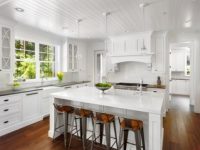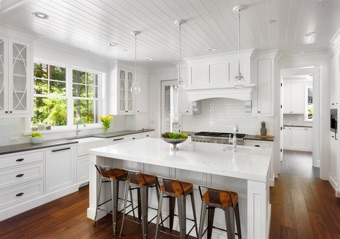When working with kitchen renovation clients, you will find that every homeowner has unique opinions about layouts, colors, and designs. Cabinet replacement or refacing services are a great option to improve the function and aesthetics of the room. Through this customized process, your clients can hand-pick the materials and features that will transform their kitchen into the heart of the home.
As a kitchen renovation expert, you need to be adaptable to meet each homeowner’s differing needs. Some people want the latest styles and modern trends. Others prefer a classic look to maintain the historic elements within the home.
Since you serve a wide variety of homeowners, you must build a portfolio to showcase varying styles and features to include in a kitchen renovation design. Understanding the design trends over time shows that your installation team is versatile and can work with a wide range of homeowners.
Cabinet Design Through the Years
Our modern cabinet designs provide function and style features that continue to improve the experience in the kitchen. Here is an overview of how kitchen cabinets are evolving over the years:
- Original Kitchen Storage: If you look back in history – even as far back as the middle ages – kitchens included wooden-plank shelving. These open-concept storage solutions held everything from pots to food, cleaning supplies, and utensils.
- Early 1900s: When the 20th century rolled around, a more organized and function approach for cabinetry became available. Shelving units and Hoosier cabinets provided extra workspace and placed everything at the chef’s fingertips. Standalone cabinet systems were popular until around 1935 when The Great Depression affected every industry.
- Mid-1900s: After the depression was over, homeowners started favoring built-in cabinets and a utilitarian approach to improve function in the kitchen. During this time, the “fitted kitchen” became the industry standard, with integrated spaces for appliances and cabinetry. In the 50s and 60s, melamine was used to create a durable finish that lasted for years. But there were only a few color options, and these cabinets had a plastic-like appearance.
- Post-WWII: The modern kitchen designs we’re familiar with started after World War II. Technology was booming, and manufacturing advancements provided endless solutions for homeowners to reflect their personalities in the designs of their kitchens. Early laminate came into the scene in the ’70s, but the materials and quality were much different from what we know today.
- Modern Cabinets: Today’s manufacturing creates a seemingly endless supply of products, materials, finishes, and designs. Homeowners can choose everything from solid wood to particleboard, fiberboard, plywood, metal, laminate, melamine, and more.
Upcoming Trends in the Cabinet Industry
Not only do homeowners want to recreate the kitchen they found on Pinterest, but people often want to be on the cutting-edge of industry trends. These trends will continue to change over time, with significant industry shifts happening about every 10 years. Your remodeling business can maintain success if you are putting in the effort to stay current as the newest colors and materials are coming into the scene.
Consider these upcoming trends for 2021:
- Open Shelving: Open shelves are becoming trendier in 2020, and we’re expecting this trend to continue next year as well. This design makes the kitchen feel lighter and open, which is why many people favor it in smaller kitchens.
- Color Combinations: Gone are the days when homeowners wanted all of the cabinets to be the same colors. People are choosing to add bold splashes of color. For example, a popular trend is white cabinetry on top with darker blue or grey tones for the lower cabinets.
- Soft Close Drawers: Cabinet doors provide access to the storage space, but many people feel like it’s a hassle to reach items in the back of the cabinets. Oversized drawers will be the design of choice for many families, with soft-close attachments to glide the drawers opened and closed.
As a kitchen remodeler, you’re always adapting to meet your customer’s needs in maintaining the timeless beauty of classic build-ins or creating a modern kitchen. Keeping your team knowledgeable on the design trends over time, gives you an edge in the industry. You can show potential clients possible designs that will make their house into the home of their dreams.









![[Podcast] Built Better: Maximizing the Value of Your Leads: Lightfire Partners](https://modernize.com/wp-content/uploads/2020/12/Lightfire-Epidsode-1-364x120.jpg)









